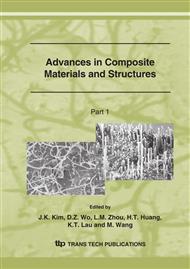p.661
p.665
p.669
p.673
p.677
p.681
p.685
p.689
p.693
Preparation of Carbon Nanotube Reinforced Epoxy Resin Coating and its Microwave Characteristics
Abstract:
The carbon nanotubes were prepared by catalytic decompose of benzene using floating transition method at 1100~1200°C. Benzene was used as carbon source and iron as catalyst with sulfur. The carbon nanotubes are straight with diameter 30~80nm, internal diameter 10~50nm and length 50~100μm. The carbon nanotubes and epoxy resin were sufficiently mixed. The mixture was smeared on to a pure aluminum plate layer by layer until the thickness of the composite layer reached 1.0 mm. The coating resin was cured by heating under infrared radiation. Complex permittivity, permeability and microwave reflectivity of carbon nanotubes reinforced epoxy resin coating had been investigated at the frequency ranges of 8.2~12.4GHz and 2~18GHz respectively. The real part (ε′) of complex permittivity of this coating ranges from 14.87 to 13.86, and the imaginary part (ε″), from 6.42 to 5.87, the loss tangent tgδε (ε″/ε′), from 0.42 to 0.45. The real part (μ′) of complex permeability of this coating ranges from 1.02 to 1.14, and the imaginary part (μ″), from 0.08 to 0.11, the loss tangent tgδμ (μ″/μ′), from 0.06 to 0.11. The maximum absorbing peak of the carbon nanotube reinforced epoxy resin coating is 22.89 dB at 11.40GHz. The band width (R<-10dB) of this coating with thickness of 1.0 mm is 3.0GHz, band width (R<-5dB) is 4.7GHz at the frequency range of 8~18GHz. This carbon nanotube reinforced epoxy resin coating would be a good candidate for microwave absorbing material.
Info:
Periodical:
Pages:
677-680
Citation:
Online since:
March 2007
Authors:
Price:
Сopyright:
© 2007 Trans Tech Publications Ltd. All Rights Reserved
Share:
Citation:


